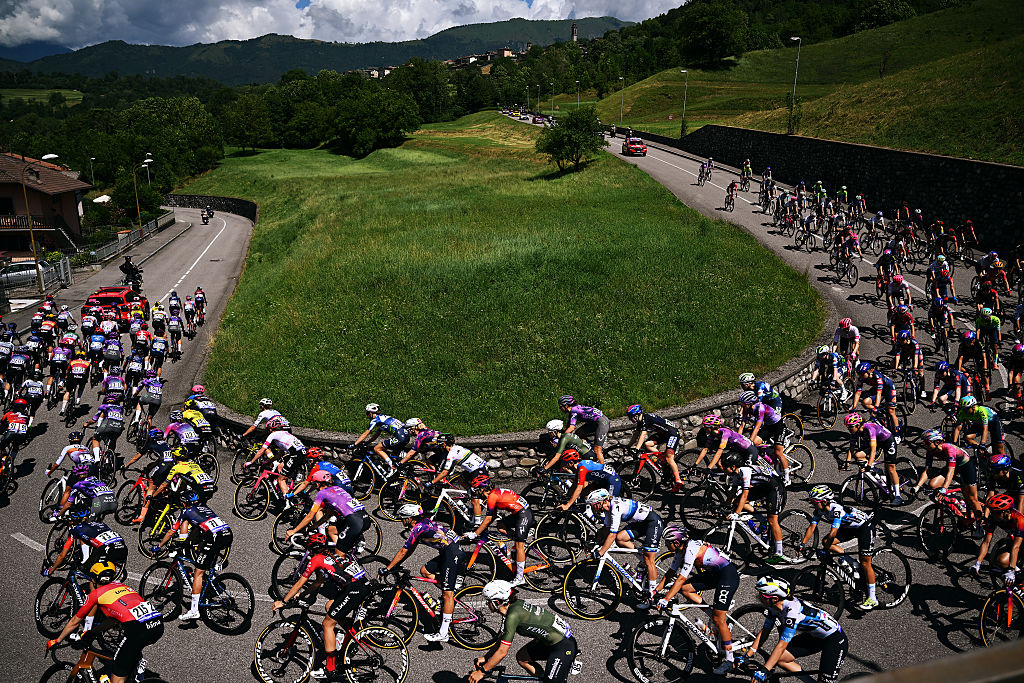Eladio Jimenez wins after a great strategy
Eladio Jimenez (Comunidad Valenciana) displayed his climbing abilities to all when he won one of the...










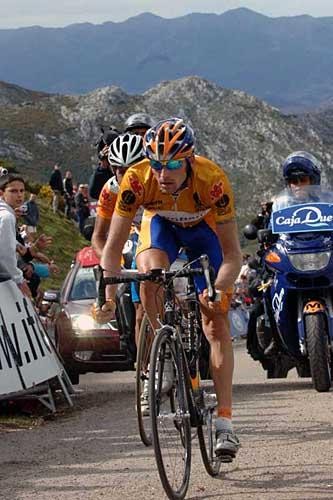

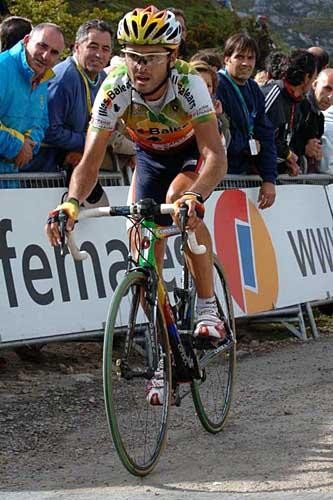
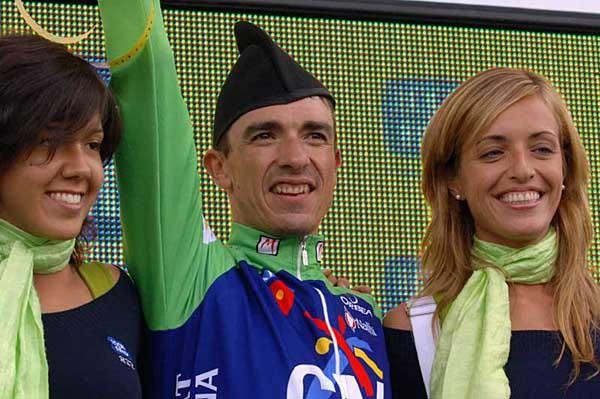









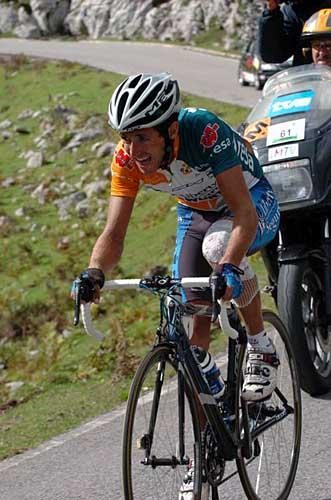



































Denis Menchov resists behind Heras’ wheel
Eladio Jimenez (Comunidad Valenciana) displayed his climbing abilities to all when he won one of the most important stages of the Vuelta a España at Lagos de Covadonga. Iñigo Cuesta (Saunier Duval) was second, finishing 1’20 behind, with Gilberto Simoni (Lampre-Caffita) a further 12 seconds down in third. Carlos Sastre (CSC) was next, with Vuelta leader Denis Menchov (Rabobank) and Roberto Heras (Liberty) finishing together in fifth and sixth. The Russian retained the golden jersey after a very tough stage, perhaps the toughest of the whole race, while Heras (second on GC) couldn’t reduce the 47-second gap on his favorite terrain.
Jimenez went away with 14 others after 39 kilometres of racing. "I was able to get into the right breakaway," said the stage winner. "In the end, I was able to use my strengths to reach the finish line in first place". He dedicated his victory to his best friend, Santos, who got married today and also to his girlfriend, who was at that wedding. "This win is for them," said Eladio, who also asked in public for a ProTour opportunity for his team Comunidad Valenciana.
"I tried to do the best I could," a rather upset Carlos Sastre told the press. "I had good feelings; I saw that Roberto [Heras] could perhaps not keep his teammate’s pace and I tried my best. I didn’t look back, concentrating on trying to reach the best possible result in this Vuelta. We will take it day by day now and see what the future has for us". In finishing fourth today, the CSC rider moved up a place to third on GC.
Liberty-Würth team director Manolo Saiz was, understandibly, not happy with the result. "Roberto [Heras] was supported by the team throughout the whole stage until La Huesera [the toughest part of the stage] where he had to attack. Menchov was behind Heras’ wheel," told Saiz. "Although he tried it many times, Menchov was doing very well and we couldn’t leave him behind. At this point, we were not capable of getting rid of Menchov. But tomorrow will be another day," added the director.
How it unfolded
Tom Boonen (Quick Step) and David De la Fuente (Saunier Duval) were non-starters at La Penilla today. The Belgian rider abandoned the race because he considered the next two tough mountainous stages wouldn’t be helpful to his preparation for the World’s. That left a total of 145 riders in the Vuelta.
At km 39, 15 riders led the race with the peloton 32 seconds behind: Eladio Jimenez (Comunidad Valenciana), Bart Dockx (Davitamon-Lotto), Marcus Burghardt (T-Mobile), Heinrich Haussler (Gerolsteiner), Angel Gomez (Saunier Duval), Guido Trenti (Quick Step), Unai Osa (Illes Balears), Anthony Charteau (Bouygues Telecom), Joaquin Rodriguez (Saunier Duval), Bram De Groot (Rabobank), Iñigo Cuesta (Saunier Duval), Igor Gonzalez de Galdeano (Liberty-Würth), Martin Elmiger (Phonak), David Cañada (Saunier Duval) and Aketza Peña (Euskaltel-Euskadi), followed by Constantino Zaballa (Saunier Duval), Jose Vicente Garcia Acosta (Illes Balears) and David Bernabeu (Comunidad Valenciana). Some kilometers later, Angel Gomez lost contact with the breakaways.
As the kilometers ticked by, the gap between the breakaways and the peloton increased. At km 74, the advantage was 5’38. At the summit of the third stage climb (Collada de la Hoz) the breakaway were a full 7’04 behind the big group.
The race went through two of the most beautiful Spanish regions full of mountains and green sceneries: Cantabria and Asturias. The leaders were able to maintain a good gap on the peloton here. At km 106, the 14 riders were 7’40 ahead. Then, at the foot of the Alto del Ortigueiro, the break had their maximum advantage of 8 minutes and 12 seconds. From that moment on, the peloton accelerated their pace and it began to make inroads into the break’s lead. The bunch wanted to catch the breakaways before the climb of Lagos de Covandonga but those up front resisted, knowing they had to preserve a good advantage to stand a chance.
The 14 breakaways: Haussler, Cañada, Cuesta, Jimenez, Rodriguez, Dockx, Trento, Osa, Gonzalez de Galdeano, Peña, Burghardt, Elmiger, De Groot and Ardila maintained a strong pace, but the peloton was determined to swallow them up before Lagos. At km 142 (30 km to go) the gap was drastically reduced to 5’54. The big favorites were beginning to take control.
At the foot of Lagos de Covadonga, 12 km from the end, Eladio Jimenez attacked his breakaway companions. The peloton was 2’50 behind. This move ultimately proved to be the right one, with Unai Osa and Iñigo Cuesta the only two riders able to – initially - keep the pace that Jimenez set.
Two kilometers later, there was a big selection in the front of the peloton. Joseba Beloki, Angel Vicioso and Michele Scarponi (Liberty-Würth) accelerated in order to help Roberto Heras. But the Liberty leader wasn’t as good as he wanted to be, following the crash in stage 12. Denis Menchov maintained what has been a very profitable strategy for him: staying glued to Heras’ wheel while tackling the mountains. And so today the results were the same as in the other stages of the race: namely, the Russian resisted the attacks of Heras.
Carlos Sastre (CSC) saw Heras wasn’t at his best and attacked the head of the peloton with 10 km to go. However, Sastre’s effort wasn’t enough to get a good gap over Roberto Heras, nor to win the stage.
Jimenez rode with a strong, relentless tempo. At La Huesera, the hardest part of Lagos de Covadonga where the slopes were 14%, the Comunidad Valenciana rider maintained his rhythm and didn’t lose time to the chasers. With 7 km to go, Jimenez was 1’50 ahead of Sastre and around 2 minutes ahead of Menchov and Heras.
La Huesera showed Heras wasn’t at his 100% condition. He tried to get rid of Menchov, was unable to do so. In keeping pace, the Rabobank rider showed that he had a real chance of winning the Vuelta.
Despite the acceleration behind, Jimenez continued to hold a gap of 1’49 over Sastre and 1’58 over Menchov and Heras with six kilometers remaining.
Once the slopes eased, Simoni was able to reel in Menchov and Heras and jump away them. Much of the last three kilometers were downhill and appeared to be easy for Jimenez, who had time to do a torero move when crossing the line in first place. Next came Iñigo Cuesta and Simoni, with Sastre, Menchov and Heras following behind.
Stage 15 - September 11: Cangas de Onis-Pajares, 191 km
The climb of Pajares will be crucial for the Vuelta. This will be a key stage with five climbs: Alto de la Faya de Los Lobos (Category 3, 740 meters above sea level, km 55.6), Alto de la Colladona (Cat. 1, 850 m., km 79), Alto de San Emiliano (Cat. 3, 540 m., km 114.6), Alto de la Colladiella (Cat. 1, 900 m., km 137.6) and Puerto de Pajares (Cat. special, 1380 m., stage finish). Puerto de Pajares is 14.2 km long, has a maximum gradient of 17% and an average of 6.1%. It may represent the last chance for Roberto Heras to regain the maillot oro. Given the race circumstances, if Menchov holds on for another day in the high mountains, the final victory will be much, much closer for the Russian.
The latest race content, interviews, features, reviews and expert buying guides, direct to your inbox!
Latest on Cyclingnews
-
Why are star riders at the Tour de France trying to avoid leading the biggest race of the year?
Mind games, press duties, and a three week long chess match -
Amazon Prime Day: All the best deals from the final day of the sale
Amazon Prime Day is here, and we've unearthed 60 deals that our readers will love -
Giro d'Italia Women abandons: All of the riders who have left the 2025 race so far
Race is down to 140 riders heading into the sixth stage -
Why is Jonas Vingegaard the only rider on his team to wear a red helmet at the Tour de France?
The Visma-Lease a Bike team leader is the only one wearing the red and white Giro helmet



